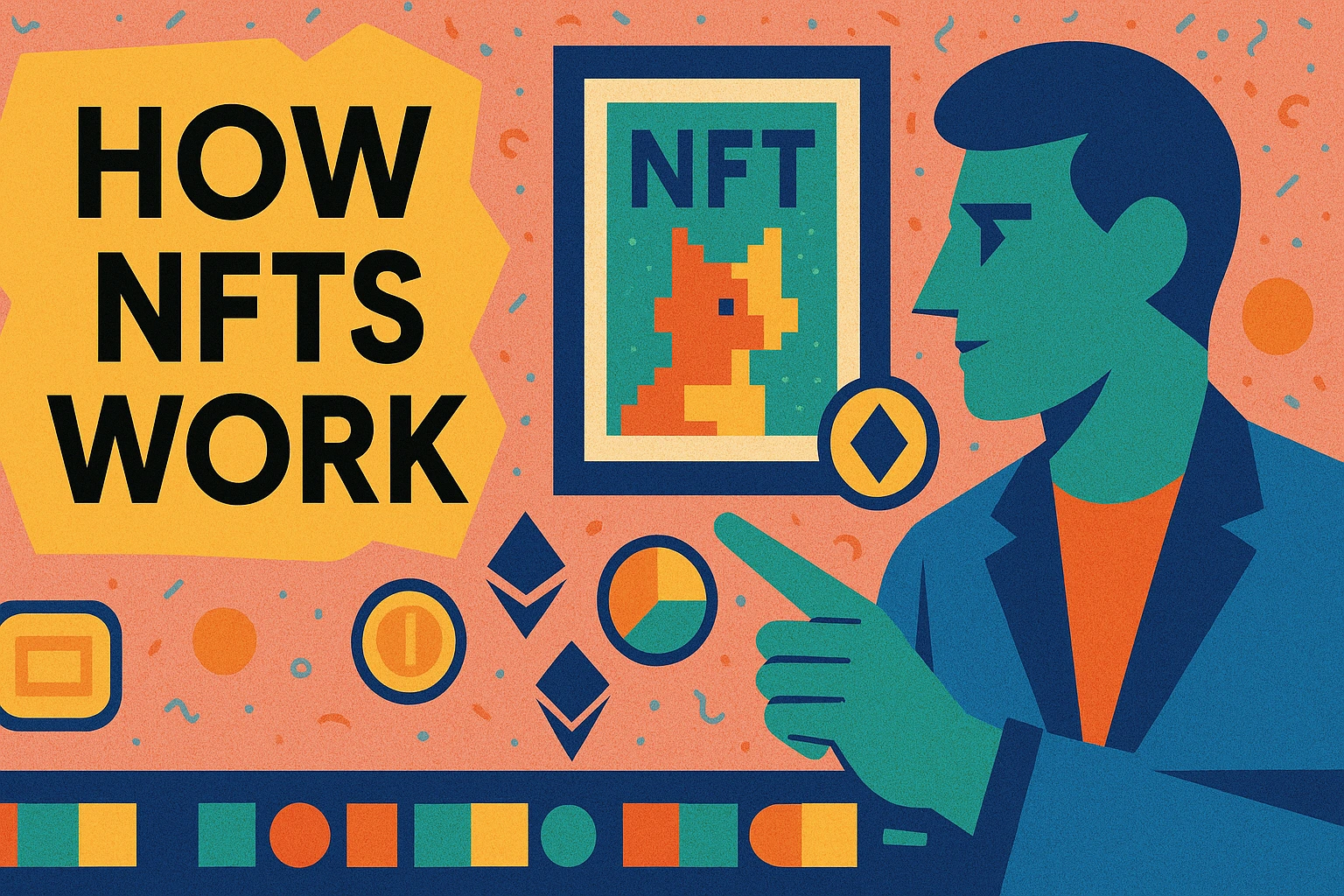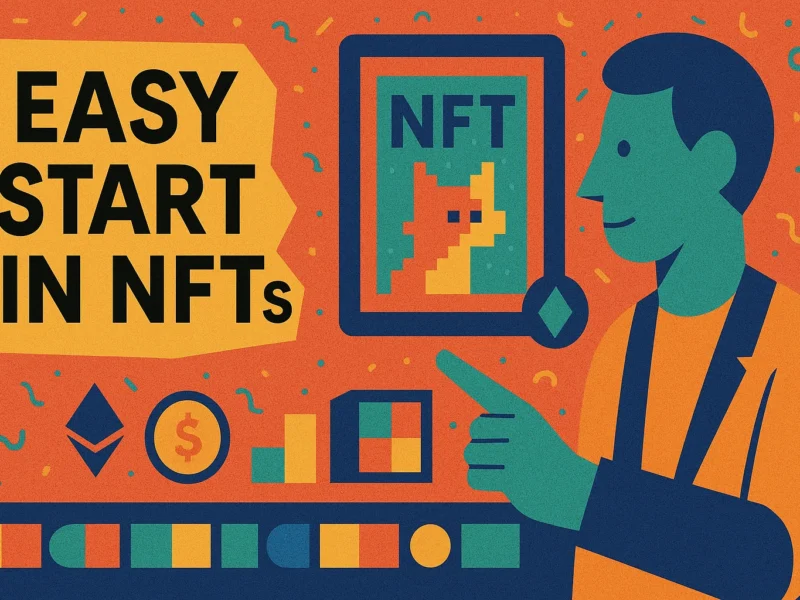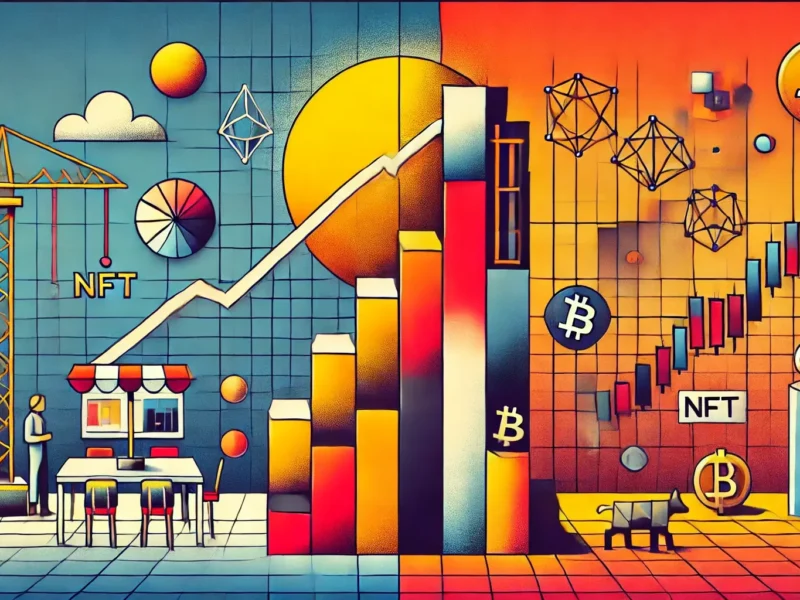NFTs-non-fungible tokens-burst into the mainstream in 2021, turning JPEGs into million-dollar assets and artists into blockchain celebrities. But beyond the headlines and memes lies a profound shift in how we create, verify, and transfer ownership in the digital world.
NFTs are not just about art or collectibles. They represent a new layer of programmable ownership built on cryptographic principles, smart contracts, and blockchain infrastructure.
In this 3-part series, we will explore:
- Part 1: The underlying technology that powers NFTs
- Part 2: The NFT marketplace and ecosystem of creators, collectors, and platforms
- Part 3: Applications beyond art-NFTs in gaming, identity, real estate, and beyond
What Exactly Is an NFT?
An NFT is a digital certificate of ownership stored on a blockchain. Unlike cryptocurrencies like Bitcoin or Ethereum, which are fungible (one BTC = another BTC), each NFT is unique and non-interchangeable.
Key Characteristics
- Uniqueness: Each token has distinct metadata and identifiers
- Indivisibility: Most NFTs can’t be split into smaller units
- Provenance: Blockchain tracks ownership history publicly and immutably
- Interoperability: NFTs can move across platforms and wallets using shared standards (e.g., ERC-721, ERC-1155)
“NFTs are the atomic units of digital ownership.” – Anil Dash, co-creator of the first NFT prototype
Cryptography at the Core
NFTs rely on public-key cryptography, the same principle used in cryptocurrencies, to verify ownership and secure transactions.
Digital Signatures
When you buy or mint an NFT:
- Your wallet signs the transaction with your private key
- The blockchain confirms the signature and associates the NFT with your public address
- Anyone can verify the signature and trace the token’s history
| Layer | Role |
| Public Key | Owner identifier |
| Private Key | Authenticator of transactions |
| Digital Signature | Verifiable proof of action |
“Ownership in Web3 is a matter of cryptographic truth, not screenshots.” – Punk6529, NFT thought leader
NFT Standards and Smart Contracts
NFTs exist because of smart contracts, self-executing programs stored on a blockchain. They define how tokens behave, who owns them, and what can be done with them.
Key NFT Token Standards
| Standard | Chain | Description |
| ERC-721 | Ethereum | First standard for non-fungible tokens |
| ERC-1155 | Ethereum | Multi-token standard (fungible + non-fungible) |
| SPL Token | Solana | NFT implementation on Solana chain |
| BEP-721 | BNB Chain | Binance’s version of ERC-721 |
Metadata and Storage
NFT metadata contains crucial information like:
- Title, description, creator
- Links to media files (e.g., image, video, 3D object)
- Traits and rarity data (for PFP collections)
However, the actual media file is often stored off-chain using:
| Method | Description |
| IPFS | Decentralized file system (content-addressed) |
| Arweave | Permanent, blockchain-based storage |
| Centralized (AWS, Google Cloud) | Quick, but vulnerable to data loss or censorship |
“An NFT without decentralized metadata is just a receipt with an unreliable URL.” – Molly White, crypto critic
How Minting and Transactions Work
Step-by-Step: Minting an NFT
- Create asset – Upload digital content (image, music, etc.)
- Deploy smart contract – Typically an ERC-721 or 1155 contract
- Mint token – Metadata is created and permanently logged on-chain
- Assign ownership – Token is linked to the buyer’s wallet
NFT Transactions
- Involve gas fees, depending on the blockchain used
- Trigger a state change in the smart contract
- Are irreversible once confirmed
| Blockchain | Avg. Fees | Speed |
| Ethereum | $5–$80 | ~15 seconds |
| Polygon | <$0.01 | ~2 seconds |
| Solana | <$0.01 | ~1 second |
| Tezos | ~$0.01 | ~30 seconds |
Interoperability and Portability
NFTs aren’t locked into a single website or platform. If built correctly, they can:
- Be viewed and traded across marketplaces (OpenSea, Rarible, Magic Eden)
- Display in various metaverse environments
- Move between layer-1 and layer-2 networks
“NFTs are passports to the open metaverse.” – Yat Siu, Animoca Brands
Creators and Artists – Ownership in the Digital Era
NFTs have empowered a new generation of digital creators to monetize their work without relying on intermediaries.
From Art to Identity
Creators in the NFT space span multiple domains:
| Creator Type | Example | Format |
| Digital artist | Beeple, Pak | Static/dynamic visuals |
| Musician | 3LAU, RAC | Tokenized albums |
| Photographer | Justin Aversano | Limited-edition prints |
| Game developer | Sky Mavis | Playable items and avatars |
Minting an NFT is more than uploading a file-it’s staking a claim of origin that’s verifiable forever on-chain.
“Before NFTs, digital art was a second-class citizen. Now it’s museum-worthy.” – Beeple, digital artist
Marketplaces and Platforms
The NFT economy runs on smart contract-powered platforms that facilitate buying, selling, minting, and display of tokens.
Major NFT Marketplaces
| Marketplace | Chain | Key Features |
| OpenSea | Ethereum, Polygon, Arbitrum | Largest general-purpose NFT platform |
| Blur | Ethereum | Pro trader-focused interface |
| Magic Eden | Solana, ETH, BNB | Gaming + collectibles |
| Objkt | Tezos | Art-focused, eco-friendly |
| Foundation | Ethereum | Curation + limited access |
These platforms provide creator dashboards, royalty controls, and metadata editing tools (pre-freeze). Fees typically range from 2% to 10%.
Monetization Models – Royalties, Auctions, Drops
NFTs create new economic mechanics that allow creators to profit directly-and passively.
1. Primary Sales (Drops)
- Creator mints and sells NFTs directly to collectors
- Often structured as:
- Fixed price
- Dutch auctions (descending price)
- Randomized minting (“generative drops”)
- Fixed price
2. Secondary Market Royalties
- Smart contracts allow creators to earn a cut on every resale
- Standard is 5–10%, though enforcement is platform-dependent
| Platform | Royalties Enforced? | Notes |
| OpenSea | Optional (2023+) | Creators must enable on-chain filters |
| Blur | Partial | Incentivizes royalty-optional collections |
| Foundation | Yes | Enforced by design |
| Magic Eden | Yes | Especially on Solana collections |
“Royalty streams are a form of creator equity. NFTs make that programmable.” – Trevor McFedries, Founder of Friends With Benefits DAO
Understanding NFT Valuation and Speculation
What Determines NFT Prices?
- Scarcity – Limited edition or 1/1 pieces
- Utility – Access to communities, games, airdrops
- Rarity Traits – Especially in PFPs (e.g., Bored Ape with gold fur)
- Creator Reputation – Historical success or following
- Market Sentiment – Hype cycles, influencer endorsements
The Floor Price Metric
“Floor price” = lowest price of a token listed in a collection. Often used as a signal of:
- Collection health
- Investor confidence
- Entry-level investment
| Collection | Avg. Floor Price (2024) | Chain |
| Bored Ape Yacht Club | ~30 ETH | Ethereum |
| Azuki | ~5 ETH | Ethereum |
| DeGods | ~6 SOL | Solana |
| Pudgy Penguins | ~8 ETH | Ethereum |
“NFTs are less about the JPEG and more about the access, utility, and speculation wrapped around it.” – Farokh, NFT influencer
Community, DAOs, and Token-Governed Networks
NFTs have given rise to token-gated communities and creator-led economies.
What Is a DAO?
A Decentralized Autonomous Organization is a smart contract-based group where token holders govern:
- Treasury spending
- Project direction
- Access and privileges
Examples:
| DAO | Purpose |
| Nouns DAO | Funds creative and social causes through daily NFT auctions |
| PleasrDAO | Collects cultural NFTs and digital relics |
| Krause House | Aims to buy and manage a real NBA team |
NFTs serve as membership cards, voting rights, and contribution logs.
Market Bubbles and Burnouts
The NFT market has faced boom-and-bust cycles since its rise:
| Year | Milestone | Commentary |
| 2021 | $69M Beeple sale | Mainstream breakthrough |
| 2022 | $40B+ in sales | Market euphoria |
| 2023 | Bear market | 90% value drop in some collections |
| 2024 | Recovery through utility | Focus shifts to gaming, IP, and AI-generated NFTs |
While some collections became overhyped and overpriced, the core technology remains solid, evolving toward sustainable applications.
NFTs in Gaming – Assets, Economies, and Ownership
NFTs are redefining the economics of video games, enabling true digital ownership of in-game assets and player-driven economies.
GameFi and Play-to-Earn
In blockchain-powered games, NFTs represent:
- Characters, skins, weapons
- Land, resources, or in-game currencies
- Achievements or event tickets
Top Games Using NFTs:
| Game | Chain | NFT Role |
| Axie Infinity | Ronin (Ethereum sidechain) | Playable characters |
| The Sandbox | Ethereum | Land and building blocks |
| Illuvium | Immutable X | Creatures and items |
| Big Time | Ethereum | Cosmetic collectibles |
Interoperability and Player Ownership
- Items are owned by the player’s wallet, not locked in a server
- NFTs allow cross-game compatibility in some metaverse ecosystems
- Revenue is shared between developers, players, and asset creators
“Players now own what they earn-and that changes everything.” – Gabby Dizon, Yield Guild Games
NFTs in Real Estate – Tokenizing Property and Ownership Rights
Physical assets like land and buildings are being tokenized via NFTs, making fractional ownership and transparent transfer more accessible.
How It Works
- A property’s legal claim or share is represented by an NFT
- Smart contracts define ownership terms, dividends, and sale conditions
- Buyers can verify provenance and transact directly without notaries
Examples:
| Platform | Use Case |
| Propy | Real estate sales with on-chain titles |
| Roofstock onChain | Tokenized single-family rentals |
| RealT | Fractional property investing |
Benefits
- Reduced middlemen and paperwork
- Faster, global transactions
- Transparent ownership history
“In the future, homes will come with deeds-and wallets.” – Natalie Brunell, Real Vision contributor
Identity, Credentials, and NFTs as Digital Passports
NFTs offer a way to verify and carry identity or certifications without revealing sensitive data.
Use Cases
- Digital diplomas issued as NFTs (e.g., MIT pilot project)
- Event access and tickets that prevent scalping and forgery
- KYC credentials that users own and selectively disclose
Examples of Tools:
| Tool | Purpose |
| POAP | Proof-of-attendance for events |
| BrightID | Social identity verification |
| ENS (Ethereum Name Service) | Blockchain-based usernames and addresses |
The Rise of Soulbound Tokens (SBTs)
Proposed by Vitalik Buterin, SBTs are NFTs that can’t be sold or transferred, ideal for:
- CVs and resumes
- Medical records
- Memberships
“NFTs will help us own our data and our identity-not just our media.” – Glen Weyl, co-author of Soulbound paper
Enterprise and Industrial Applications
NFTs are being used behind the scenes by corporations and governments to streamline digital operations.
Enterprise Use Cases
- Supply chain transparency: Authenticity, timestamping, and product provenance
- Document certification: On-chain notarization of contracts and agreements
- IP and licensing: Media and software rights as tradeable tokens
Corporate Adopters:
| Company | Application |
| Nike | Sneaker verification (Cryptokicks) |
| IBM | Supply chain tokenization |
| Ticketmaster | NFT-based event tickets |
| Starbucks | Loyalty programs with Polygon NFTs |
Legal and Regulatory Considerations
NFTs straddle the line between digital property and financial instrument, raising complex legal questions.
Legal Uncertainties
- Are NFTs securities? Some regulators say yes if there’s profit expectation
- How are NFTs taxed? Varies by country (capital gains vs. collectibles)
- What if off-chain data disappears? Raises consumer protection issues
Regulatory Movements (As of 2024)
| Region | Action |
| USA | Ongoing SEC scrutiny over NFT-based fundraising |
| EU | MiCA legislation expanding definitions to include NFTs |
| China | NFT platforms allowed under tight supervision (non-crypto) |
| Japan | Licensed NFT marketplaces now regulated as asset platforms |
“We must protect innovation without compromising on investor protection.” – Gary Gensler, SEC Chairman
NFTs and the Future of Web3
NFTs are more than collectibles-they are keys to the decentralized internet. In Web3, NFTs enable:
- Decentralized identity and reputation systems
- Access to DAOs, DeFi tools, and exclusive services
- Self-custody of digital property and assets
- Earning power through ownership, royalties, and participation
“NFTs are the gateway drug to Web3. They teach people what digital ownership really means.” – Li Jin, Web3 investor
Final Thoughts: Beyond the Hype
NFTs started with memes, art drops, and mania-but beneath the volatility lies a robust framework for digital property, verified by code and enforced by consensus.
The next era of NFTs will not be about hype-it will be about:
- Ownership that works across platforms
- Identity that you carry and control
- Rights, royalties, and records secured by the blockchain
As regulation matures and infrastructure improves, NFTs may become as fundamental to the digital age as domain names were to Web1-or social profiles to Web2.

Leanora Leeper is a 38-year-old P2E expert. She is an ex-cybersport player who has competed in national and international tournaments. Leanora has a bachelor’s degree in business administration and is currently pursuing her master’s degree in the same field. She has held several positions of responsibility in both the public and private sectors.
Leanora is highly sought after for her expertise in the area of P2E (production to end-user). She has consulted for many large organizations, helping them to improve their processes and increase their efficiency. Leanora is known for her no-nonsense approach to problem solving and her ability to get things done quickly and efficiently.



